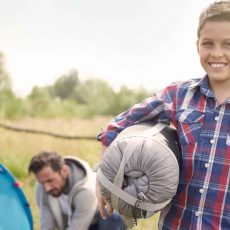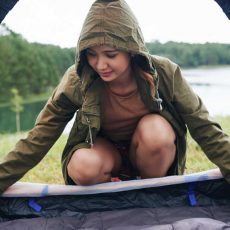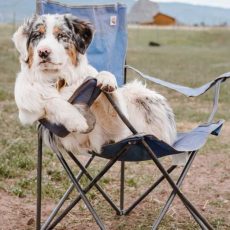
How to keep food cold while camping
Is there anything better than an icy cold drink at the end of a busy day of camping? We think you can’t beat it, so in this post we’ll show you how to not only keep your drinks cold, but to manage the temperature of your food to make it last the whole trip, and to keep you safe from food poisoning.
Keeping your food cold while camping can take a bit of practice, but after a while you’ll be a pro at both preparing your food and packing your cooler for optimal freshness and coolness while on your trip. The ideal temperature for food to prevent food poisoning is 40°F (or 4°C) and we’ll also show you later in this post how you can monitor this during your trip.
Finding a solution to keep your food cold not only keeps you safe from food poisoning, but also means you can stay away longer before needing to top up supplies of either food or ice and means you’re not reliant on camp kitchens and shared fridges which may or may not have spare space in them!

Our top tips to keep food cold when camping
Use block ice (not party ice)
The bigger the block of ice, the longer it takes to melt, so using big blocks of ice rather than ice cubes means you can keep your food colder for longer. You can make your own ice blocks at home before you leave (just fill up old ice cream containers for example), or even better, use milk bottles or soft drink bottles and freeze those. That way, you won’t have melting ice mixing in with your food, and you’ll have fresh, cold drinking water to drink as the ice in the bottles melt.
Ice, ice baby
The freezing point of salt water is lower than fresh water, therefore it takes longer for salt water to melt than fresh water. Simply add salt and water to a bottle, then freeze it (but make sure you label it so you don’t accidently drink it!). Plus the saltier it is, the lower the freezing point!
Freeze meals before you go
Cooking and freezing meals before you go not only means you’ll have meals ready to eat when you’re camping, but it means that the meals themselves act as ice blocks keeping other food cold. You can also freeze uncooked food (such as cuts of meat) and if you let them defrost slowly in the cooler they’ll not only keep longer, but will help to keep the cooler cool! Save the biggest pieces until last (such as a whole chicken for example), giving it maximum time to contribute to the cool environment it is sitting in as it slowly defrosts.
Pack your cooler well
There are two main things you are trying to achieve when you pack a cooler. Firstly, you want the largest, and coldest (i.e. frozen) food on the bottom, working your way up to the lightest and freshest food on the top. The reason for this is three-fold, one, the cold air circulates downwards keeping the items at the top of the cooler longer, two, the colder air doesn’t escape every time you open the cooler, and three, you don’t squash your food! So put items such as frozen meals, meat and drink bottles towards the bottom, and fruit and vegetables at the top.
Insulate, and keep out of the sun
Insulation is the name of the game with a cooler. You want the cooler to both keep cold air in, and keep warm air out. To help it out, cover your cooler with a blanket, towel or rug (or buy a purpose-built cover for it), and keep it in the shade.
No gaps!
A tightly packed cooler will stay colder for longer compared to one that allows the air to circulate freely. So when you pack it in the first place, try and fill in the gaps (such as with freezer blocks). As you use the food and drink the drinks, you can put newspaper as a layer on the top to create a “false ceiling” within the cooler and keep the air trapped down low for as long as possible.
Try to start cold, and stay cold
If you can help it, try not to make your cooler work too hard by adding hot things to it and expecting it to cool them down. If you add hot items to your cooler, the ice inside will need to transfer its coldness to the warmer items, thus melting in the process. It’s not always possible, but do your best to start your trip with everything going into the cooler cold. If you do need to add things along the way, try and do it gradually (such as one item out, one item in), or on the days when you can add ice as well.
Don’t open it too often
This is a tough one with kids around as they like to go into the cooler every five minutes to grab a drink or a snack, but try and train them to only open the cooler when they need to, and for as short a time as possible. This gives the cold air the best chance of staying inside the cooler rather than escaping out. And make sure they shut it properly when they’re done too!
Run two coolers
Leading on from the point above, it can be useful to run two smaller coolers rather than one big one. That way, you can have one for drinks where people are going in and out of it frequently, and one for your food that only gets opened at mealtimes. Plus it is often easier to fit two smaller coolers into your car rather than find a spot for one big one.
Use dry ice (if you can access it)
Dry ice is reasonably common in the US (you can buy it in ??) and will keep your food very cold! But handle with care! Wrap the dry ice in newspaper and keep it away from food you don’t want to get too cold (such as vegetables). Don’t touch it with bare hands, and definitely don’t let the kids near it unless they are old enough to understand how to handle it properly.
Cool it!
Now that you know all about keeping food cold, it’s time to find the best cooler for the job! You might also like to buy a thermometer, and some ice packs so you have everything you need. If you have access to power (either in your car, via solar panels/batteries or at a powered camp site) you could even upgrade to a camping fridge/freezer (no ice required!), plus you might like to consider a smaller cooler bag for day trips (to put your packed lunch in).



